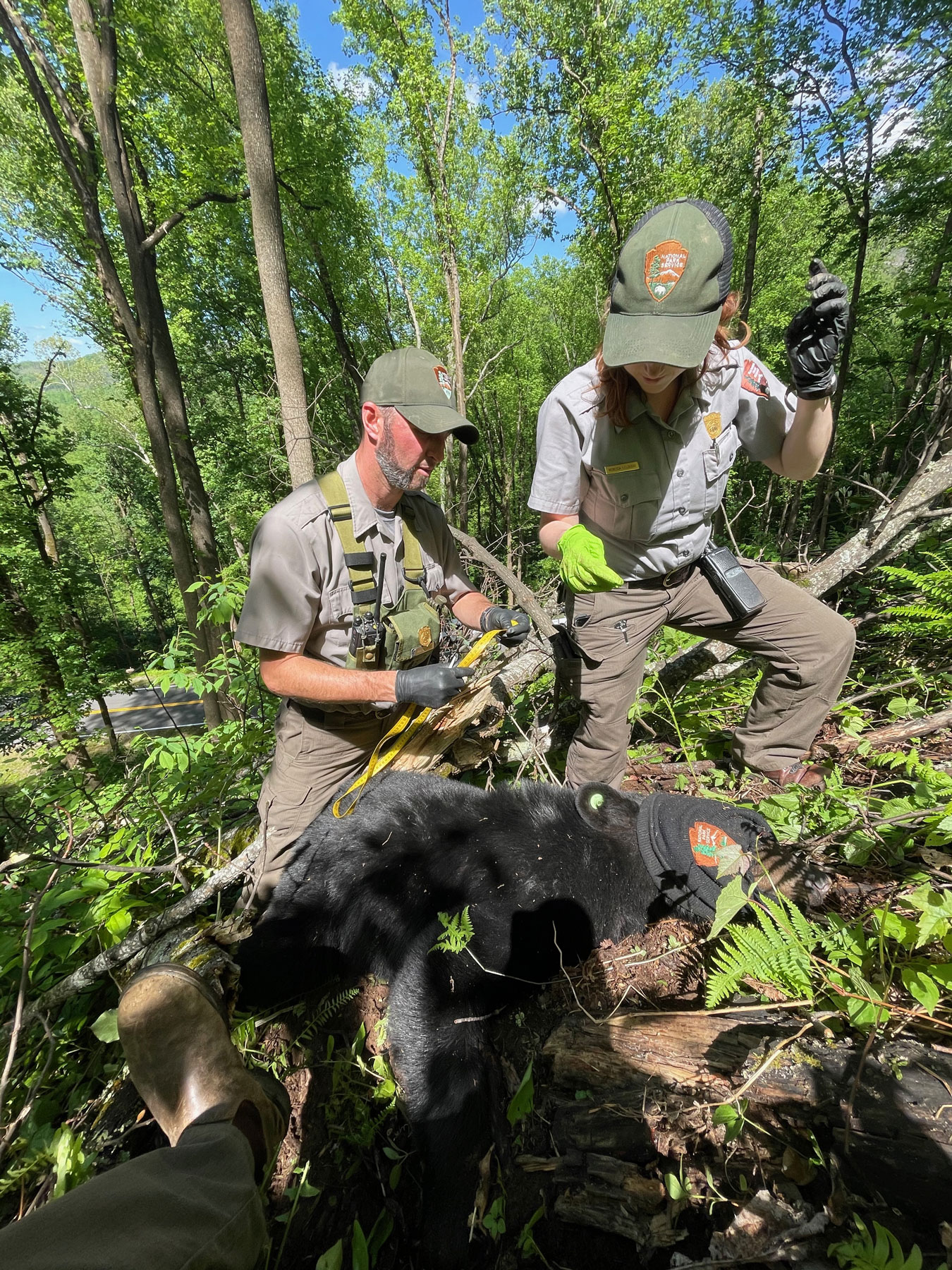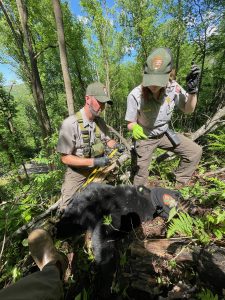
Editor’s Note: This essay is part of a series written during Railback’s stay in the park from June 22 to August 4, 2023.
July 11: I am writing in a fever dream, words flying onto the page as I reach the final paragraph of the novel I’ve come to Great Smoky Mountains National Park to write, Peter Quince Becomes a Bear. Movement outside my window. I look up and 15 feet from where I sit, a black bear paws at the ground near a tree—a young female I will come to know as Bear #1298.

When I arrived at my apartment at Cades Cove, I imagined long hikes into the wilderness to observe bears. I had no idea a short bike ride or walk from my place would often take me to a bear. I’ve seen as many as five different bears in one day. At Cades Cove in summer, they seem to be everywhere.
The fields and woods of the cove, rich with food, bring in the bears (perhaps as many as two thousand). And the bears there attract curious humans (certainly more than two thousand on any day in the summer). Few places in the world put such high concentrations of bears and humans together. The difficult task of making this coexistence possible falls to park wildlife experts, rangers, and volunteers (for an excellent memoir of this work, read Bear in the Backseat by Kim DeLozier and Carolyn Jourdan).
Park wildlife biologist Ryan Williamson’s job gets tougher as the bear and human populations grow. Mother bears teach cubs to avoid people, but when someone feeds a bear or leaves food out or a bear happens upon an easy meal (say, a bowl of dog food), that life-saving education fades. Being practical, a food-conditioned bear goes for the quick meal, which might be in a car or tent. And the owner of that car or tent may or may not be able to shoo the bear away.
“When it’s bear versus human,” Williamson says, “the bear always loses.” He and others working with him will dart a conflict bear, bring it to the wildlife building, study it, tattoo a number on the inside of the bear’s lip, attach two ear tags, and sometimes a GPS tracking collar. The bear is known by an assigned number.
Williamson will try everything to give the bear another chance. It will be put in a trap made from an old culvert and subjected to loud noises, such as firecrackers, and even tasing upon release. If the bear relearns to fear people, it has a much better chance for survival. The bear has the potential to be relocated to the farthest corner of the park or outside the park to national forest lands, but all too often it will travel 30 or 40 miles and come right back. “Bears have an incredible homing instinct,” Williamson says.
Many years ago, a conflict bear could be readily relocated outside the park to a remote area. With the expansion of human development and increase in bear population, that option becomes less desirable.
“There is no further or deeper into the woods,” Williamson notes. Relocating a bear outside the park requires a maze of authorizations and layers of state and federal bureaucracy. A relocated bear faces many adversities, including death by speeding vehicle, hunters, or landowners. “About two-thirds of the bears relocated outside the park are dead within four months,” Williamson says.

When no place is left for a habituated, food-conditioned bear that runs into people repeatedly, the bear will be darted, euthanized, and sometimes necropsied for study—an end that Williamson wants desperately to avoid.
On July 12, the Smokies BearWise Task Force meets in Gatlinburg and on Zoom. BearWise (bearwise.org) gathers park and state wildlife experts, area businesspeople, community leaders, and concerned park partners to find ways to keep bears alive and people safe. During routine reports about bear activity, Williamson introduces the group to Bear #1298 and turns his monitor toward the metal table in the park wildlife building where, darted, she sleeps.
Typical for a female of three years, she weighs 70 pounds. Probably born in the park in 2021, by the time she reached approximately 18 months of age, her mother kicked her loose. In a park saturated with bears, finding her own home territory wasn’t easy. Bear #1298 discovered that the campground at Cades Cove provided a haven. Williamson believes that some animals seek “human shielding” by staying at a place with so many people that predators or territorial competitors avoid it.
Bear #1298 becomes habituated to humans but not food-conditioned; she stays out of trouble. However, she cannot be left to wander the campground.
On June 20, she is darted, taken to the building, and given her number. Relocated to a far end of the park, at Tritt Cemetery, nevertheless she travels over 33 miles and returns to Cades Cove by July 31. Williamson plans to dart her again, but a no-shoot order is issued for the park so he must wait. The battery dies in her GPS collar on August 8, and Bear #1298 is gone.
Williamson expects she will retire to a den some time in December and likely emerge with cubs. He would not be surprised to see her at Cades Cove in the spring of 2024.
Bear #1298 navigates difficult terrain and times, as do those who work to keep her and her kind alive. I think of her often and hope she will thrive.
In his haunting final collection of essays, Embrace Fearlessly the Burning World, the naturalist Barry Lopez writes of a black bear who often visited his remote Oregon home: “When I go to sleep tonight, the bear will be out there in the woods somewhere, lifting his head to the night breeze. What am I to do if he turns up in my dreams?”
Subscribe to get the latest posts sent to your email.
The Great Smokies Welcome Center is located on U.S. 321 in Townsend, TN, 2 miles from the west entrance to Great Smoky Mountains National Park. Visitors can get information about things to see and do in and around the national park and shop from a wide selection of books, gifts, and other Smokies merchandise. Daily, weekly, and annual parking tags for the national park are also available.